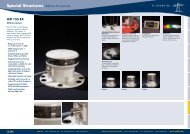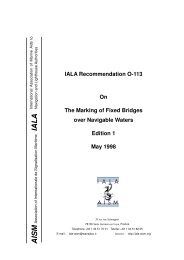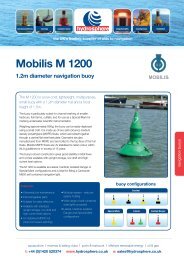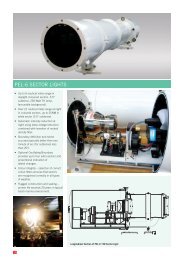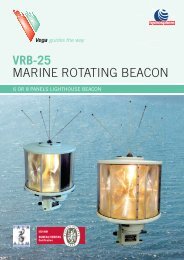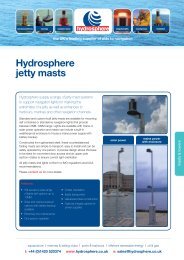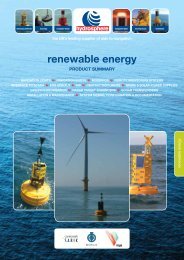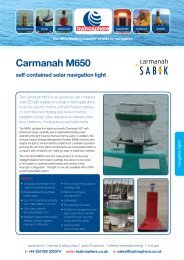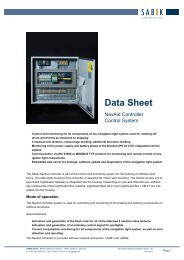Hydrosphere UK Ltd Complete Products & Services Catalogue
Hydrosphere UK Ltd Complete Products & Services Catalogue
Hydrosphere UK Ltd Complete Products & Services Catalogue
Create successful ePaper yourself
Turn your PDF publications into a flip-book with our unique Google optimized e-Paper software.
MULTIPLE PEL SECTOR LIGHT APPLICATIONS<br />
Provide Extra Subtense (Red Sea)<br />
One PEL-6-20D light and two PEL-6 lights with 10.75° subtense<br />
are mounted on a single station and project a total subtense<br />
of 41°. An overlap of 0.25° between lights ensures the full<br />
sector is covered. A wider coverage is achieved than could<br />
be provided with a single light, and vertical divergence is less.<br />
The relationship between subtense, intensity and colour fi lter<br />
transmission is used to good effect – the intensity from the<br />
10.75° lights (in coloured sectors) is about the same as the<br />
20° light (in white sector).<br />
Mark a Restricted Area<br />
Two or more lights can be used to provide a fi x over a<br />
restricted area. The lights are read as a pair (or group), and<br />
may also be fl ashed in sync to aid identifi cation. The area<br />
defi ned by the lights may be quite irregular. Sectors can<br />
be any size and in any sequence, limited only by the total<br />
subtense of the light. Restrictions can be to keep vessels<br />
inside (anchoring area, turning basin) or exclude entry<br />
(no-anchoring zone, hidden shoal or other danger area).<br />
Floating buoys may not be required.<br />
Red Sea<br />
Shoal<br />
Projected Display<br />
8˚ 25˚ 8˚<br />
One PEL-6-20D Sector Light<br />
Two PEL-3-10.75D Sector Lights<br />
Two PEL-3-15D Sector Lights<br />
Mark a Parallel Channel<br />
The channel can also be convergent or divergent, and the<br />
same lights used by a dredge. Each light has two sectors,<br />
and the lights are read as a pair, perhaps fl ashing in sync.<br />
An oscillating sector on the inside of each boundary is possible.<br />
This example is used when the taper shape of a single sector<br />
is too much compromise. The advantage of this method over<br />
leading lights is that both sector lights only require the intensity<br />
of a front lead, and that even at great viewing distances the<br />
sensitivity is not reduced.<br />
Mark an Undersea Pipeline (Taranaki, NZ)<br />
Two wide-angle anamorphic PEL Sector Lights are used<br />
to defi ne a no-trawling corridor between an offshore oil<br />
production platform and the shore station. This is to protect<br />
the underwater pipeline connecting the two. The restricted<br />
area is defi ned when both lights are red. In this case the<br />
lights are not synchronised, but have different characters,<br />
and because the background is unlit farmland, relatively low<br />
intensities are adequate. Marker boards are used to defi ne<br />
the corridor during the day.<br />
Position<br />
A<br />
B<br />
C<br />
Signal<br />
Production Station<br />
A<br />
B<br />
C<br />
Pipeline<br />
Converging Beam<br />
Two PEL-6-5D Sector Lights<br />
Position<br />
A<br />
B<br />
C<br />
A B C<br />
Signal<br />
Platform 22.54NM<br />
Two 150 Anamorphic<br />
PEL Sector Lights<br />
18



